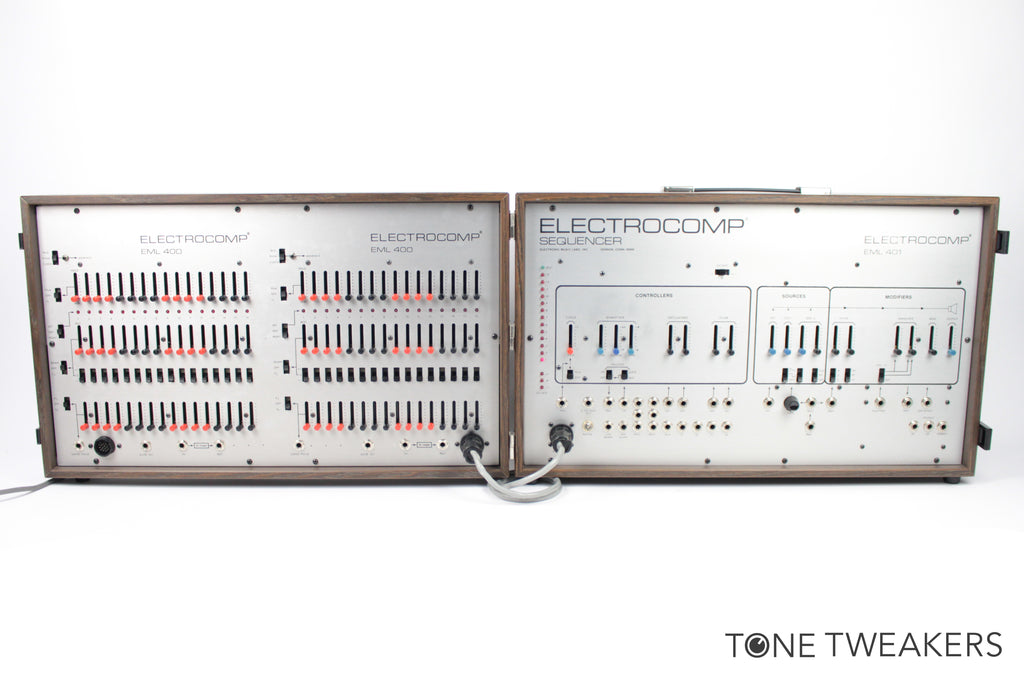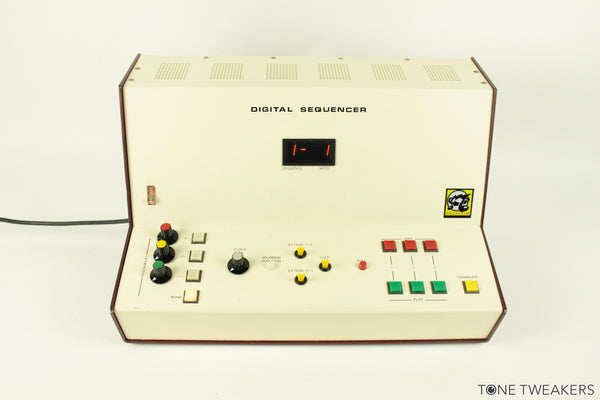EML Electrocomp-400
EML Electrocomp-400
Please contact us to discuss pricing.
EML Electrocomp-400 Sequencer for sale. Meticulously overhauled and in perfect working order, unlike most. This was a very time consuming and costly process which is justifiably reflected in this instrument's high price.
The unit shown here has been sold but we have another we should be able to prepare for sale - email us.
The EML-400 / EML-401 is our favorite analog sequencer. But it's not just a sequencer, it's also a flexible 2 oscillator analog synthesizer based on the popular EML-500! Consider this the synth workstation of the 70s! It can be used as a stand alone unit or with other CV gate synths like ARP Moog Sequential Circuits etc. The quantized out may not play proper quantized pitches on your synth from another manufacturer since EML was "nonstandard" but the non-quantized voltages should still be very useful in any modular synth studio. The beauty of an analog sequencer is that it's got knobs you can adjust for the different pitches of your sequence. Each of these knobs puts out a different voltage, which is then routed to your oscillator/s to determine pitch. Similarly, on some analogue sequencer like this one, you can take these voltages and patch them into other voltage control inputs. Common inputs allowing control are filter pedal and volume pedal ins, though most analog modular synths have lots of inputs like these for controlling a number of parameters. Use it to make complex modular analog synth sequences, arpeggios, rhythmic loops, etc. This Electro-comp sequencer is way better than the ARP sequencer. It has a whopping SIX rows of 16 faders, each of which can be used to control parameters on the internal synth or any compatible external synthesizer.
If you look at the photos, you will notice that the left side (or sequencer control section) has two columns of 3 rows of 16 faders. These two columns can provide two different sequences (up to 16 steps each) running in parallel with one another or running in series as one a massive 32 step sequence. Each side can be set to a different number of steps and can run simultaneously. The top row of faders can be used to control the clock tempo or length of the envelope settings. The middle row can output a quantized voltage so there is no need to stand there all day to fine tune each step to play exactly the pitch you want - the quantizer takes care of that and only plays the notes, not the in betweens! The bottom row has a feature called gated pulse. Whenever a fader in this row is above 20% of its range, a gated pulse is sent out the jack below. This can be used to fire off envelope generators, etc. Pretty cool, huh? All 3 rows mentioned can alternatively each put out a non-quantized voltage used for controlling any voltage controlled parameter, internal or external to this system.
Compare this to the Arp sequencer which has only 16 faders total. Makes the ARP look kind of wimpy, doesnt it? The EML400 / EML401 clock can be driven by an external trigger such as those provided by the Roland TR-808 and TR-909 drum machines or similar. This will allow you to synchronize the sequencer with a number of other devices, including some equipped with MIDI. We haven't tried audio signals though the right short triggered sample might do the trick.
The synthesizer section has 2 oscillators, a cool multimode filter (lowpass, bandpass and highpass), an envelope generator and a very effective ring modulator / amplitude modulator. You can patch an external signal into the filter along with the oscillators (and mute the osc's too if you wish), and can modulate the filter cutoff and pitch with external voltages.
Last but definitely not least, the quantizer voltage is applied to a vertical row of red and green LEDs on the left side of the right 1/2 of this unit. As the sequence advances its step while it plays a pattern, the lights jump to the pitch being played. This allows you to visualize your melodies. Kind of like the Triadex Muse does, but this is way more controllable than a Muse (if you want a Muse though, let us know as we may be able to help). In our opinion, there is no piece of sexier vintage synth gear than this. Turn the lights out in your studio and you'll probably agree!




















